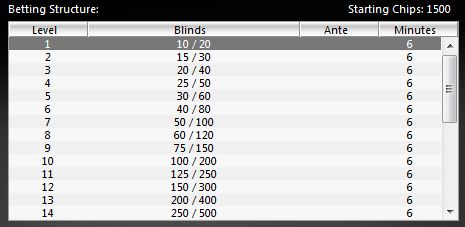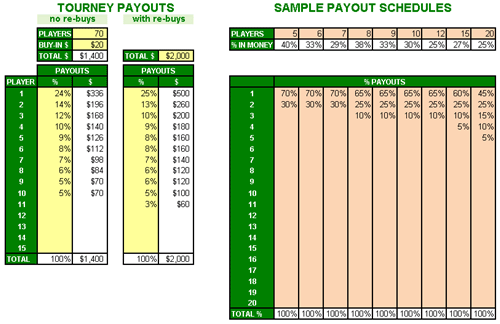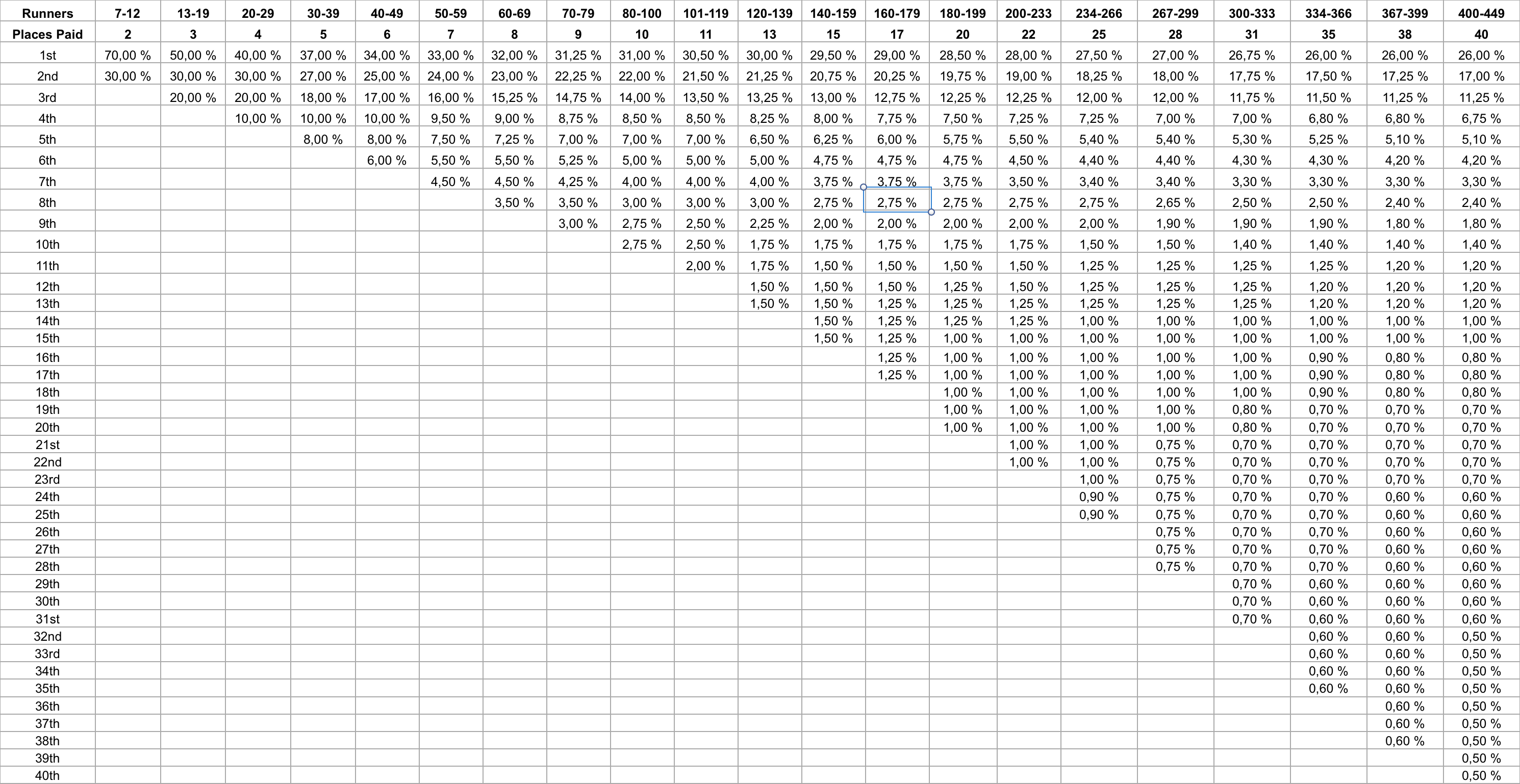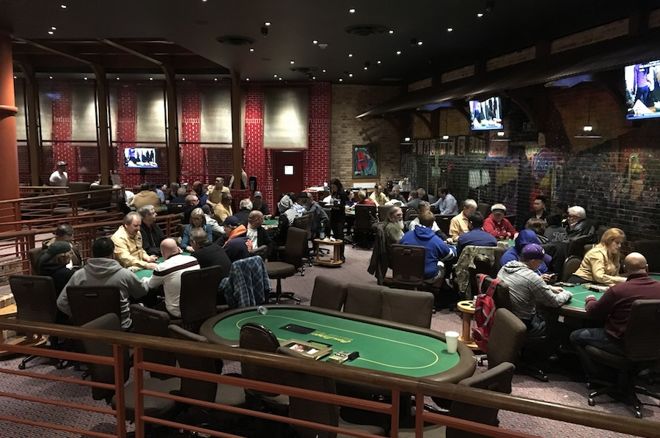Tournament Blind Structure Theory. Starting Number of Blinds. Most tournaments start with 50-100 big blinds. Anything around 200 big blinds is considered a 'deep stack' tournament. Rebuys and Add-ons. Blind Level Round Length. Gradual Blind Increase.
The blind structure (or schedule) is one of the most important details of running a successful tournament. Gradual increases of the blinds at each level and finishing on time are characteristics of a good blind structure.
To calculate a blind structure, the minimum information you need is the number of players, target duration, and the starting blind level (which is usually the smallest chip denomination you have). It is also necessary to know how many chips there will be in play and how many rounds there will be. The blind calculator tool below can take care of that and help set up your perfect structure.
- Every poker tournament series, event and festival in the US and Canada is here on PokerAtlas, including the World Series of Poker (WSOP), World Poker Tour (WPT), Heartland Poker Tour (HPT), and all others. Click on any event for the full tournament schedule, including dates, start times, buy-ins, structures, and details about each.
- A schedule of Bellagio poker tournaments, including time, buy-in, blind structure, and more. You also can find Bellagio phone number, address, and website info.
- Play The Right Starting Hands. Whether it be lack of patience, or an unfamiliarity with opening.
To calculate a blind structure, you need the starting blind level, the estimated total value of the tournament chips in play (initial buy-ins plus rebuys and add-ons) and the desired length of the tournament. Use the tool below to help set up your perfect structure.
Please enter the smallest chip denomination
Please enter a tournament length
Please enter the number of players
This section discusses some tournament blind structure theory, which explains why the PokerSoup.com tournament blind structure calculator suggests blind levels the way it does and what you can change to create the right blind structure for your game.
Starting Number of Blinds
Most tournaments start with 50-100 big blinds. Anything around 200 big blinds is considered a 'deep stack' tournament. Deep stack tournaments are considered to be full of skillful poker play and not just pushing your money all in before the flop. The latter occurs quickly in tournaments that start with less than 50 big blinds, which are also aptly nick-named 'luck-fests'. There just aren't enough chips to maneuver and play real poker.
If all other variables are held constant, starting a tournament with larger chip stacks will increase the length of the game.
Rebuys and Add-ons
The number of rebuys and add-ons in a tournament also effect the total number of chips in play during a tournament. If no other changes are made, more rebuys and add-ons make for a longer tournament.
Blind Level Round Length
Most live tournaments employ blind level lengths of 15, 20, 30, 45, or 60 minutes. The blind calculator can calculate blinds for any of these blind levels. With a set tournament length, longer blind levels result in less number of rounds and shorter blind levels result in more rounds.
Gradual Blind Increase
The greatest benefit of using the PokerSoup.com tournament blind structure calculator is the assurance of constantly increasing blind amounts. This is an important aspect of tournament play. If the blinds increase (preferably slowly) at a constant rate, players do not spend an inordinate amount of time being deep- or short-stacked and there are no game-altering blind increases in the middle of the tournament.
For example, if the blinds increase from 150/300 to 200/400, that is an increase of 33%, or (200+400)/(150+300). This is a comfortable increase. Similarly, in the later stages of the tournament after many players are knocked out, a blind increase from 3000/6000 to 4000/8000 is also 33%.
End Goal
Eventually, the blinds (and antes) induce action to end the tournament. After all, a tournament usually does have a set duration (or a goal, anyway). As a player, it is up to you to figure out how aggressive it is necessary to play in order to keep up with the blinds. Constant gradual increases make this easier to figure out.
Playing tournaments is currently the most common way people now experience poker. I have played in literally hundreds of thousands of them and will tell you exactly how they work.

How do poker tournaments work? Poker tournaments differ from cash games in that each player pays an entry fee then competes to win a portion of the prize pool. During the event, the blind levels increase steadily at regular intervals. A tournament officially ends once one player has all of the chips and is declared the winner.
Now, let’s break down every feature and phase of poker tournaments from beginning to end.
How Do Tournaments Differ from Cash Games?
In cash games, the chips represent actual money. So each chip won or lost goes into or comes from your actual bankroll. In tournaments, there is a set entry fee that is paid and, no matter what, that is the most money that you can lose during the event
How Does a Poker Tournament Entry Fee Work?
Every poker tournament has a set entry fee that is the same for all players. The prize pool and the rake (the house fee) are both included in one fee
- If the prize pool portion is $50 and the rake is $5, the entry fee will be disclosed as $50+$5.
10% rake is a fairly standard, however, some smaller live events have rake has high as 30%.
What Is the Difference Between a Freezeout, a Rebuy, and a Reentry tournament?
There are two typical ways that the entry fee of a tournament is structured:
- Freezeouts – A freezeout means that each player can only buy in one time. Once a player runs out of poker chips, his or her tournament is over. This is the most common type of tournament.
- Rebuys – A rebuy means that there is a specified period of time at the beginning of a tournament when players may buy more chips if their stack falls below a certain level or they bust out. The cost of the rebuy is usually the same as the entry fee, minus the rake.
- Reentry Tournaments– A reentry tournament is the same as a rebuy except that a player must be eliminated before buying back in. They also do not get to keep their seat. Instead, it is treated as if it is an initial buy-in and the player is reseated at another table.

What Is an Add-On?
In rebuy events, there is usually a specific number of extra chips offered to players at the end of the rebuy period. This is known as an add-on which typically costs a full entry fee.
How Do Poker Tournaments Pay Out?
Every tournament has a set way that they divide up the prize pool. Almost all tournament payout structures are top heavy. In other words, the top few places usually receive the lion’s share of the prize pool.
What is a typical Payout Structure?
The majority of the field in any poker tournament do not win anything. The number of players who “cash” in an event will vary.
Poker rooms usually payout between 10% and 30% of the field in a multi-table tournament (MTT). For single table tournaments, 33% of the field will typically win money.
Here is a typical payout structure commonly used by poker rooms. It shows what the payouts will be depending on the number of entrants.
MTT Prize Structure Example
| Entries> | 2-4 | 5-7 | 8-12 | 13-18 | 19-27 | 28-36 | 37-50 |
| 1st | 100% | 65% | 50% | 40% | 40% | 33% | 29% |
| 2nd | – | 35% | 30% | 30% | 23% | 20% | 18% |
| 3rd | – | – | 20% | 20% | 16% | 15% | 13% |
| 4th | – | – | – | 10% | 12% | 11% | 10% |
| 5th | – | – | – | – | 9% | 8% | 8% |
| 6th | – | – | – | – | – | 7% | 7% |
| 7th | – | – | – | – | – | 6% | 6% |
| 8th | – | – | – | – | – | – | 5% |
| 9th | – | – | – | – | – | – | 4% |
How to Read the Prize Structure Chart
The top row tells you how many entrants are in an event. The rows below show you what each place will pay based on the number of entrants.
For example, if a tournament had 22 entrants, then you’d use the “19-27” column. Looking down the column you will see that 5 people would be paid out between 9 and 40% of the prize pool.
When Is the Final Prize Pool Established?
- In freezeout tournaments, the final prize pool is established once the initial entry period ends. Sometimes entries are closed at the start of the first deal and sometimes there is a specified period of time when players may buy-in to the event.
- In Rebuys, the final prize pool is not known until the end of the rebuy and add-on period. The final prize pool will always be much higher than it was at the beginning of a rebuy tournament.
How Is the Winner Determined?

The winner of a poker tournament is determined when only one player has all the chips. The last phase before the end is when two players battle it out “heads-up“.
What are Guaranteed Tournaments (GTD)?
Guaranteed tournaments have a minimum prize pool pre-set before the event. What this means is that if there are not enough buy-ins to meet the guaranteed amount, there is something called an “overlay.” An overlay means that the event basically begins as if several people had already busted out.
However, poker rooms know exactly how many people tend to sign up for a particular tournament, so they offer guarantees based on the usual prize pool. Therefore, overlays are rare and a guaranteed is effectively just a gimmick used to attract more players.
Even so, knowing the guarantee of a particular tournament is a good tool for professional players to use when planning their playing schedule.
How Are Poker Tournaments Set Up?
Most poker tournaments are played on a 9 or 10 seat table. Only one deck is used if there is a dedicated dealer. If the event is a home game or pub poker tournament, there are often two alternating decks in play. Typically, the player in the big blind will shuffle during the hand.
How Is Seating Determined?
Before play can begin the players must be properly seated. There are three typical methods used to determine
- Random draw is the most common form of seating found in live multi-table poker tournaments. When a player pays his or her buy-in, the seat assignment is randomly given to the player by the table and seat number.
- Player choice is common in casual pub poker tournaments. This allows family members and friends to sit together to enjoy the game.
- Drawing from the deck is how seating is often determined in a single table tournament. The playing cards are typically fanned out on the table and each player gets a card. The high card gets seat one, the next highest seat two, so on and so forth. Ties are usually broken by either redrawing or using bridge order. Spades>Hearts>Clubs>Diamonds.
How Players Are Re-Seated During Play
From time to time, the number of players on the remaining tables will become unbalanced. You may have 9 people on one table, 6 on another, so on and so forth.
It is the job of the tournament director to make sure that the number of players on every table are as close to equal as possible. Therefore, players must be occasionally moved in order to maintain that equilibrium.
Usually, the director will try to move players “in position”. For example, if a person was going to be in the Small Blind, they are moved to the same position on their new table. One thing that directors
Even so, if more than 3 players are moved there will be a redraw at the new table to determine who has the button.
What Is the Structure in Tournaments?
The structure of tournaments will vary from event to event. Here are a few things that must be established in every event:
- The number of starting chips that each player will get.
- The blind level structure.
- How long each blind level lasts.
- Whether or not rebuys or re-entries will be allowed.
- Whether it is a sit and go event or has a set starting time.
Poker Chip Distribution (Starting Stacks)
This is an area where tournaments differ from other forms of poker. While cash games allow players to choose the buy-in they begin with, tournaments have one uniform starting stack size.
Average Starting Stack Size
The number of chips that poker players get at the beginning can vary wildly from event to event. For lower buy-ins and most pub poker type tournaments, the starting chips are usually in the 2,000 to 3,000 range.
Shallow Versus Deep-Stacked Tournaments
Typically, anything below 3,000 chips is considered shallow stacks and anything above 8,000 is usually considered deep-stacked. However, the effective size of the stack is relative to the size of the blinds and how fast they increase.
Poker Tournament Blind Levels
In poker tournaments the blind levels do not remain static. At set intervals, the levels increase.
This effectively decreases everyone stack size and forces the players to constantly try to increase their stacks. Otherwise, they might “blind out” and not have enough chips to even pay the blinds.
What Are the Typical Blind Levels?

The exact amounts of each blind level can vary quite a bit, but here is a common schedule:
| Level | Blinds | Level | Blinds |
| 1 | 25/50 | 6 | 300/600 |
| 2 | 50/100 | 7 | 500/1000 |
| 3 | 75/150 | 8 | 1000/2000 |
| 4 | 100/200 | 9 | 2000/4000 |
| 5 | 200/400 | 10 | 3000/6000 |
Poker Tournament Speed
Every tournament has a set interval in which the blinds go up. This can range from every 3 minutes all the way up to every 2 hours. In fact, the biggest determining factor on how shallow starting stacks are is in how fast the blinds go up.
Also, hands played per hour has an impact on tournament speed. Live events play much slower than online tournaments. Therefore, the blind intervals have to be treated differently when figuring out speed.
Tournament Speed in Live Events
At most, you usually play about 30 hands per hour in a live tournament. This doesn’t give you much time to pick up premium hands if blinds are going up quickly. With that in mind, here is a commonly accepted breakdown of live tournament speed:
| Tournament Categories | Blind Level Intervals |
| Slow tournaments | Greater than 1 hr levels |
| Average tournaments | 30 to 45 minute levels |
| Fast tournaments | 20 to 25 minute levels |
| Turbo tournaments | 15 minute levels |
| Hyper-Turbo tournaments | Less than 15 minute levels |
Tournament Speed in Online Events
Online, you can usually see between 60 and 90 hands per hour. This dramatically changes the calculations for tournament speed. Slow tournaments are blind levels of 30 minutes or longer while 15 minutes is average speed. Turbos are typically 5 minutes while hyper-turbos have 3 minute blinds.
Tournament Strategy Is Largely Affected by Speed of the Blinds
Ultimately, tournament speed is controlled by how big your starting stack is and how fast the blinds go up. One way to look at it is to figure out how fast you will blind out of the tournament if you never played a single hand. This “patience factor” is helpful in deciding both what hands to play and how to play them.
One of my favorite authors, Arnold Snyder, explains these calculations in his popular book titled Poker Tournament Formula (click to see Amazon listing). I highly recommend it if you want to improve your tournament speed play.
Poker Tournament Types

There are two basic types of poker tournaments:
- Multi-Table Tournaments (MTT)
- Single-Table Tournaments (STT)
When Does a Tournament Begin?
- Scheduled – Scheduled tournaments have a set starting time.
- Sit N Go – Sit N Go (SNG) tournaments only begin once a certain number of plays have registered and “sat down”. Most SNGs are single table events and are often associated with satellites. However, two-table up to 5-table events are common as well.
How Long Does a Poker Tournament Last?
No matter what format, all tournaments are designed to play out until there is a winner. Generally, the winner is determined when one person has won the heads-up match and has all the chips.
Ways Tournaments Can End Early
There are two ways that a tournament can end early:
- A deal is struck between the remaining players who agree to a final table payout. Once the deal is made, the event is often over. However, occasionally the players will agree to play out the event for bragging rights or for an amount set aside from the prize pool.
- The event is a satellite with a set number of seats. In that case, there is no point in continuing on once the number of players left equals the number of seats in the prize pool.
Tournament Format Variations
There are numerous variations and sub-variations of poker tournaments. I will cover the most common types that you need to know about. They are:
- Bounty Tournaments
- Spin N Go’s
- Shootouts
- Satellites
- Double or Nothings
What Is a Bounty Tournament?
In bounty tournaments (sometimes called knockouts), a portion of the prize pool is set aside as a “bounty”. Whenever someone is knocked out, the person that won their chips is immediately awarded the bounty. The introduction of a bounty alters the optimal strategy and makes loose calls of all-ins more frequent.
What Is a Spin N Go?
First created on Pokerstars, a spin n go is a fast-paced three-person sit n go that features 3-minute blinds and a prize pool that varies from event to event. The prize pool is randomly selected as a multiplier of between 2 times to 3000 times the buy-in. Players start with 500 chips in a winner take all format.
What Is a Shootout Tournament?
Shootout tournaments are basically multiple sit n go’s played over multiple rounds. At the start, there are a pre-set number of tables with between 2 and 10 players each. In the first round, play continues until there is one winner on each table. In the next round, all of the winners start anew on a new table. The rounds continue until the final table is reached and an ultimate winner determined.
What Is a Satellite?
A satellite is usually a sit n go where the prize pool is an entry into a larger buy-in poker tournament. Buy-ins to each satellite determine how many “tickets” are awarded. Sometimes only the winner gets a ticket but often there are multiple seats to be won. Satellites can be an STT or an MTT.
What Is a Double or Nothing?
Sometimes called “double-ups”, a double or nothing tournament has a flat payout structure where half the field wins twice their buy-in amount. In another variation is called, called “triple-ups”, one-third of the field wins three times their buy-in.
What’s the Best Poker Beginner Strategy?
A variety of different poker styles have been successful over the years. Therefore, there is not a one size fits all strategy. Even so, I first recommend that you learn the basic rules and fundamentals and then read a book called “Harrington on Hold’em.”
“HoH” is about as basic as it gets for tournament strategy and is a great starting point for learning how to play tournament poker hands.
Once you have played a few hundred tournaments and have a better grasp on them, I suggest that you move on to a more aggressive strategy which is laid out in “Poker Tournament Formula“, which I mentioned earlier.
Do You Recommend an Online Poker Site to Practice On?
To give yourself the best chance of success as a new player, I recommend choosing a poker site that is not too big yet not too small, that caters more to newer or recreational players.
- For players in the United States, I recommend Ignition Poker, which has anonymous games. This keeps pros from tracking your play over the long-term and taking advantage of your weaknesses.
- For players outside the United States, that cannot play on Ignition, I recommend Bodog. Bodog shares it’s player pool with Ignition and also has anonymous games.
- If you cannot play on either of the sites mentioned above, try PartyPoker or 888 Poker.
I recommend avoiding Pokerstars as a new player. They have the toughest games in the world which make it very hard to win for a newer players.
Final Thoughts
I hope you’ve enjoyed this crash course on how poker tournaments work. If there is something I failed to mention or a question that was unanswered, please let me know in the comments.
Thanks for reading and now go win that tournament!
Related Questions
Rebuy Poker Tournament Structure
Who can play in a poker tournament? In general, unless it is a close event anyone that has the entry fee may play in a poker tournament. This is what makes the World Series of Poker so intriguing. Unlike other sports, you can compete against the best players in the world without having to qualify in some way.
Poker Tournament Structure Home Game
When can you call clock in poker? Anyone may call clock on another player at any time during a poker tournament. However, this is usually only done in rare cases when a player is taking an inordinate amount of time to act. Once
Poker Tournament Structure App
What is ROI? ROI is an acronym that stands for “Return On Investment.” ROI is measured as a percentage based on how much money a poker player wins once buy-ins are subtracted from their winnings. To figure out your ROI, divide your net profit by your investment and times it by 100. For example, let’s say you win $15,000 in poker tournaments and paid $12,000 in buy-ins. Your net profit is $3,000. So, $3,000/$15,000= 0.2. When you times .2 times 100, you get 20%. Therefore, your ROI is 20%.